Climate
Mapped: 30 Years of Deforestation and Forest Growth, by Country

Global Deforestation and Forest Growth over 30 Years
This was originally published on December 29, 2021, on Visual Capitalist.
Forests are the great carbon capturers of our planet, and they are a key source of wildlife habitats and vital resources for people around the world.
But deforestation is threatening this natural infrastructure, releasing carbon into the atmosphere while simultaneously reducing wildlife diversity and making our environment more susceptible to environmental disasters.
This graphic looks at global deforestation and forest growth over the past 30 years, mapping out the net forest change by country and region using data from the UN’s Food and Agriculture Organization (FAO).
The State of Deforestation by Region
Today, forests make up around 31% of the Earth’s total land area, spanning 15.68 million square miles (40.6 million km²). Over the past three decades, the world lost a bit more than 4% (685,300 square miles) of its forests, which equates to an area about half the size of India.
Europe and Asia were the only two regions which had significant overall forest growth during this time period, while Oceania saw no significant change and North and Central America saw a slight reduction.
| Region | Forest area change (1990-2020) | Percentage change in forest area |
|---|---|---|
| Asia | +146,718 sq mi | +6.64% |
| Europe | +88,803 sq mi | +2.34% |
| Oceania | +1,057 sq mi | +0.0015% |
| North America and Central America | -7,722 sq mi | -0.34% |
| South America and the Caribbean | -501,932 sq mi | -13.30% |
| Africa | -409,268 sq mi | -14.29% |
| Global total | -685,401 sq mi | -4.19% |
Source: UN Food and Agriculture Organization
Africa along with South America and the Caribbean were the regions with the greatest amount of net forest loss, both losing more than 13% of their forests over the past 30 years. This is largely because these two regions have large amounts of forest area available, with the underlying land in high demand for agriculture and cattle-raising.
Although the overall forest loss around the world is massive, the rate of forest loss has slowed down over the past three decades. While an average of 30,116 square miles were lost each year between 1990 to 2000, between 2010 to 2020 that number has dropped to 18,146 square miles, showing that the rate of overall loss has fallen by almost 40%.
The Countries and Drivers of Deforestation and Forest Growth
Despite an overall slowing down of forest loss, certain countries in South America along with the entirety of Africa are still showing an increase in the rate of forest loss. It’s in these regions where most of the countries with the largest reduction in forest area are located:
| Country | Net change in forest area (1990-2020) | Percentage change in forest area |
|---|---|---|
| Brazil | -356,287 sq mi | -15.67% |
| Indonesia | -101,977 sq mi | -22.28% |
| Democratic Republic of the Congo | -94,495 sq mi | -16.25% |
| Angola | -48,865 sq mi | -15.97% |
| Tanzania | -44,962 sq mi | -20.29% |
| Myanmar | -41,213 sq mi | -27.22% |
| Paraguay | -36,463 sq mi | -36.97% |
| Bolivia | -26,915 sq mi | -12.06% |
| Mozambique | -25,614 sq mi | -15.29% |
| Argentina | -25,602 sq mi | -18.84% |
Source: UN Food and Agriculture Organization
Brazil, home to most of the Amazon rainforest, saw 356,287 square miles of net forest loss, largely fueled by farmers using the land to raise cattle for beef. It’s estimated that 80% of the deforested land area of the Amazon has been replaced with pastures, with the resulting beef production known to be among the worst meats for the environment in terms of carbon emissions.
The other great driver of deforestation is seed and palm oil agriculture. These oils account for about 20% of the world’s deforestation carbon emissions, and their production concentrated in Indonesia and Malaysia is now expanding to other Asian countries along with Africa.
While the demand for beef and palm oils drives deforestation, initiatives like the Central African Forest Initiative (CAFI) are providing incentives to protect forest land.
Select countries in the European Union along with the United Kingdom and South Korea have committed $494.7 million to six central African nations (Cameroon, Gabon, Central African Republic, Democratic Republic of the Congo, Equatorial Guinea, and the Republic of Congo) for them to preserve their forests and pursue low emission pathways for sustainable development. The initiative has seen $202 million transferred thus far and an anticipated reduction of 75 million tons of CO2 emissions.
Forests and the Climate Crisis
It’s estimated that forests absorb around 30% of the world’s carbon emissions each year, making them the greatest and most important carbon sinks we have on land. When you pair this with the fact that deforestation contributes around 12% of annual greenhouse gas emissions, the importance of forest preservation becomes even more clear.
But we often forget how much forests protect our environment by acting as natural buffers against extreme weather. Forests increase and ensure rainfall security, making nearby land areas significantly less susceptible to wildfires and natural droughts in hot and dry seasons along with flooding and landslides in wet seasons.
With every dollar invested in landscape restoration yielding up to $30 in benefits, reducing deforestation and investing in reforestation is considered an effective way to reduce the difficulty and costs of meeting climate and environmental protection goals. This is without even considering the benefits of maintaining the world’s largest wildlife habitat and source of species diversity, the home of the nearly 70 million indigenous people who live in forests, and the livelihood of 1.6 billion people who rely on forests every day.
Preserving and Regrowing Forests for the Future
Despite the short-term acceleration in forest loss seen in 2020, there have been positive signs about forest regrowth coming to light. A recent study found that previously deforested land can recuperate its soil fertility in about a decade, and layered plants, trees, and species diversity can recover in around 25-60 years.
Along with this, in some instances these regrowing “secondary forests” can absorb more carbon dioxide than “primary forests”, giving hope that a global reforestation effort can absorb more emissions than previously thought possible.
From better financial incentives for local farmers and ranchers to preserve forest area to larger scale policies and initiatives like CAFI, curbing deforestation and promoting reforestation requires a global effort. Reversing forest loss in the coming decades is a daunting but necessary step towards stabilizing the climate and preserving the environment that billions of animals and people rely on.
Climate
Mapped: Global Temperature Rise by Country (2022-2100P)
In this set of three maps, we show the global temperature rise on a national level for 2022, 2050, and 2100 based on an analysis by Berkeley Earth.

Mapped: Global Temperature Rise by Country (2022-2100P)
Many scientific authorities, such as the Intergovernmental Panel on Climate Change (IPCC), often discuss the need to limit planetary warming to 2°C above pre-industrial levels.
But did you know that this warming will not be evenly distributed throughout the globe due to factors such as geography, weather patterns, ocean currents, and the influence of human activities?
To discover the current and projected nuances of this uneven warming, these three maps created in partnership with the National Public Utilities Council visualize the global temperature rise by country, using new and updated data from Berkeley Earth.
Current State of Warming
The three maps above visualize warming relative to each country’s average 1850-1900 temperatures.
Looking at warming in 2022, we see that average national warming (i.e. warming excluding oceans) is already 1.81°C above those numbers, with Mongolia warming the most (2.54°C) and Bangladesh warming the least (1.1°C).
As the map depicts, warming is generally more accelerated in the Global North. One of the reasons for this is Arctic amplification.
Arctic amplification refers to the disproportionate heating experienced in the Arctic compared to the rest of the planet. This amplification is fueled by multiple feedback loops, including decreased albedo as ice cover diminishes, leading to further absorption of heat and exacerbating the warming effect.
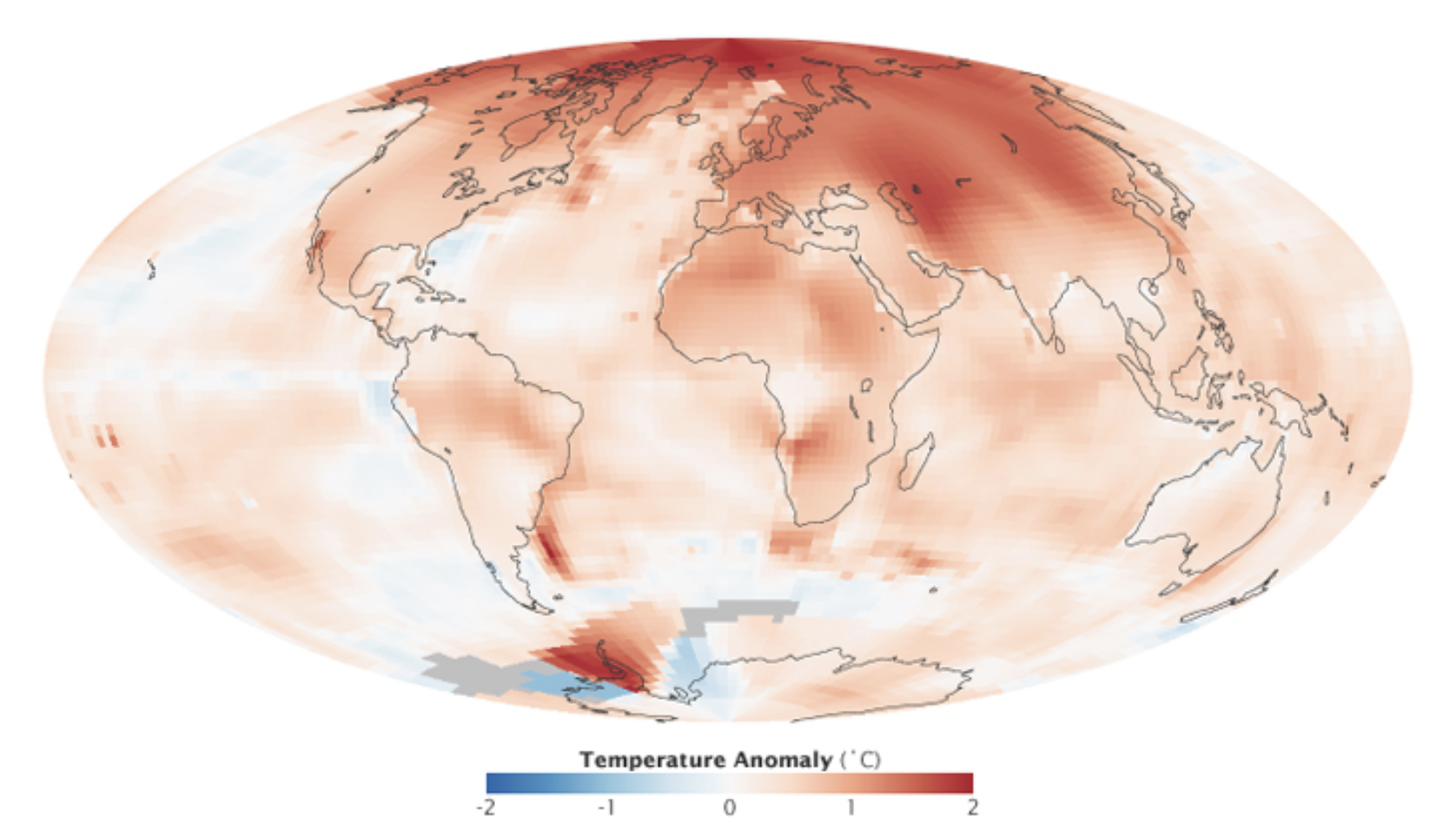
Arctic amplification. Source: NASA
Aside from modern-day observations, the effects of Arctic amplification are also clearly seen in climate models, where accelerated warming in countries such as Russia and Canada is seen through 2100.
Projected Warming in 2050 and 2100
Moving over to the second and third maps in the slides above, we discover country-level 2050 and 2100 warming projections.
These projections are based on the IPCC’s “middle-of-the-road” scenario, titled Shared Socioeconomic Pathway (SSP) 2-4.5. Out of the various established pathways, this one is the closest to expected emissions under current policies.
2050 Projections
Under the SSP2-4.5 scenario, average national warming is projected to be 2.75°C above average 1850-1900 temperatures in 2050. This includes Mongolia, with the most substantial warming of 3.76°C, and New Zealand, with the mildest warming of 2.02°C.
To put those temperatures into context, here are the risks that would likely accompany them, according to the IPCC’s latest assessment report.
- Extreme weather events will be more frequent and intense, including heavy precipitation and related flooding and cyclones.
- Nearly all ecosystems will face high risks of biodiversity loss, including terrestrial, freshwater, coastal and marine ecosystems.
- Accelerated sea level rise will threaten coastal cities, leading to mass displacement.
Let’s now take a look at 2100 projections, which would have significantly higher levels of risk unless fast and extreme mitigation and adaptation measures are implemented in the upcoming decades.
2100 Projections
2100 projections under the SSP2-4.5 scenario depict an average national warming of 3.80°C.
More than 55 countries across the globe are projected to have warming above 4°C in comparison to their 1850-1900 averages, and nearly 100 above 3.5°C.
Here is what those levels of warming would likely mean, according to the IPCC.
- 3-39% of terrestrial species will face very high risks of extinction.
- Water scarcity will considerably affect cities, farms, and hydro plants, and about 10% of the world’s land area will experience rises in both exceptionally high and exceptionally low river flows.
- Droughts, floods, and heatwaves will pose substantial threats to global food production and accessibility, eroding food security and impacting nutritional stability on a significant scale.
Generally, warming at this level is expected to pose substantial catastrophic risks to humanity, necessitating swift and bold climate action.
Learn more about how electric utilities and the power sector can lead on the path toward decarbonization here.
Climate
How Droughts Threaten the Future of Hydropower
This infographic explores how droughts are affecting U.S. hydroelectric generation and the future of hydropower.
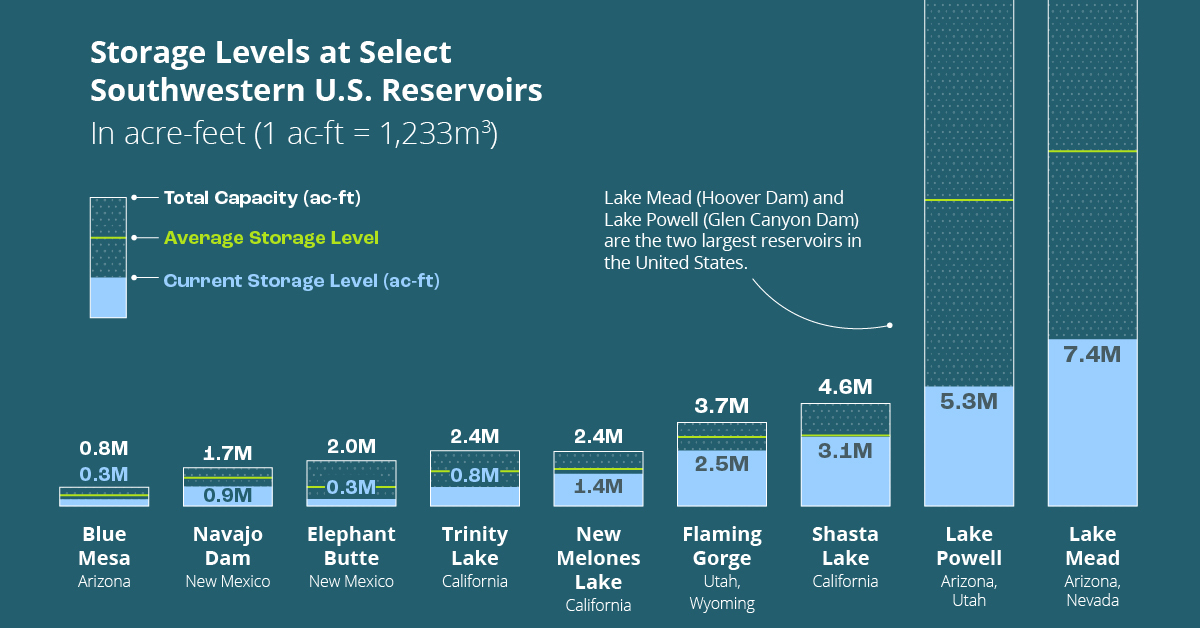
How Droughts Threaten the Future of Hydropower
Hydropower is the largest source of renewable energy in the United States, accounting for 54% of the country’s renewable electricity generation.
However, dry conditions and droughts intensified by climate change are beginning to stress hydropower generation in some regions, casting a shadow of doubt over its future.
The above infographic sponsored by the National Public Utilities Council explores how prolonged dry conditions in some U.S. regions are threatening hydropower generation. This is part two of two in the Hydropower Series.
The U.S. Megadrought
According to a recent study, the American Southwest is currently experiencing its worst megadrought—defined as a drought that lasts two decades or longer—in 1,200 years.
The multi-decade drought that began in 2000 was exacerbated by extreme-dry conditions and a hot summer in 2021. Based on the soil moisture data (covering nine states) used in the study, the 22-year period was the region’s driest spell since 821 AD.
While climate change alone did not cause this, it accounted for 42% of the intensity of the 2000–2021 megadrought. Furthermore, it also made the year 2021 20% drier than it would have been.
As of 2022, California, Nevada, Arizona, Utah, and New Mexico were among the hardest-hit states by dry conditions, which has affected both their hydropower generation and reservoir storages.
Hydropower’s Droughtful Future
In most drought-hit states, hydropower’s share of electricity generation has fallen over the last two decades.
For instance, California’s hydropower generation dropped from 25.5 million megawatt-hours (MWh) in 2001 to 17.3 million MWh in 2022. Over that same period, hydropower’s share of California’s electricity generation fell from 13% to 8%.
Besides the long-term declines in hydroelectric generation, water levels at some reservoirs are precariously low. Here’s a look at the water storage levels of select Southwestern reservoirs as of March 15, 2023:
| Reservoir | State | Total Storage Capacity (acre-feet) | Current Storage (acre-feet) | % Filled |
|---|---|---|---|---|
| Lake Mead | Arizona, Nevada | 26.1M | 7.4M | 28% |
| Lake Powell | Arizona, Utah | 24.3M | 5.3M | 22% |
| Shasta Lake | California | 4.6M | 3.1M | 67% |
| Flaming Gorge | Utah | 3.7M | 2.5M | 68% |
| New Melones Lake | California | 2.4M | 1.4M | 58% |
| Trinity Lake | California | 2.4M | 0.8M | 33% |
| Elephant Butte | New Mexico | 2.0M | 0.3M | 15% |
| Blue Mesa | Colorado | 0.8M | 0.3M | 38% |
Notably, Lake Mead (Hoover Dam) and Lake Powell (Glen Canyon Dam)—the top two largest U.S. reservoirs by capacity, respectively—have alarmingly low storage levels with less than one-third of total storage filled.
To put that into perspective, these satellite images from NASA show a bird’s eye view of the Overton Arm, a part of Lake Mead, in 2000 compared to 2021 and 2022:
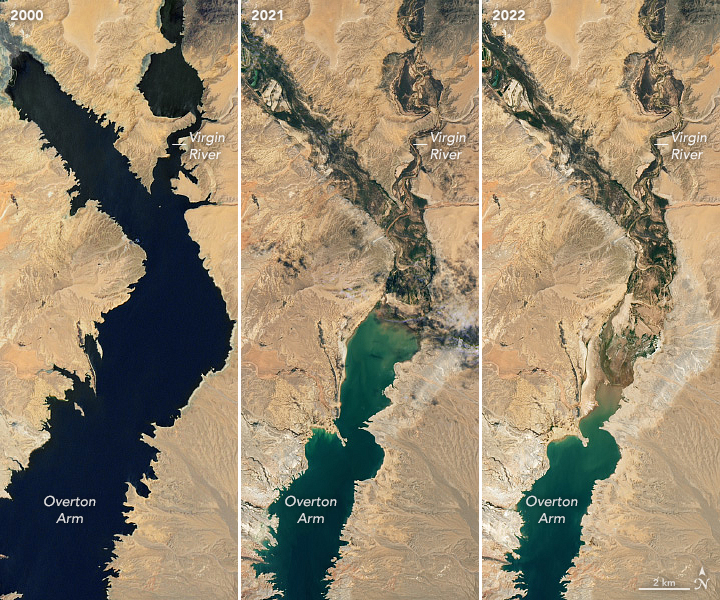
Similarly, prolonged dry conditions have pushed the storage levels of many other Southwestern reservoirs to well below their long-term averages.
The risks from these falling water levels are clear—if a reservoir’s elevation falls below a certain threshold (known as the minimum power pool), it can no longer support power generation. This occurred in 2021 when California’s Edward Hyatt Power Plant was shut down due to historically low water levels at Lake Oroville. Although the plant has resumed operations since then, the emergency shutdown is a recent example of hydropower’s vulnerability to drought.
Mitigating the Risks to Hydropower
Hydropower is one of the most reliable sources of renewable electricity and can operate at all times of the day. Furthermore, hydropower plants are important “black start” resources because they can independently kick-start electricity generation in the event of a blackout.
Consequently, a threat to the future of hydropower also poses risks for the power grid. In fact, in the summer of 2022, the NERC found that all U.S. regions covered by the Western grid interconnection were at risk of energy emergencies in the event of an extreme heat occurrence, because of dry conditions threatening hydropower.
Besides fighting climate change and working to reduce the frequency of intense droughts, here are three ways to combat the challenge facing hydropower while advancing decarbonization:
- Large-scale backup battery storage systems can be built to compensate for falling hydropower generation during severe droughts.
- Buildings and homes can be retrofitted and built with energy-efficient technologies to curb the overall demand for electricity and load on the grid.
- The power grid can be made more climate-resilient by expanding long-distance transmission lines and deploying more solar and wind power in interconnected regions.
-
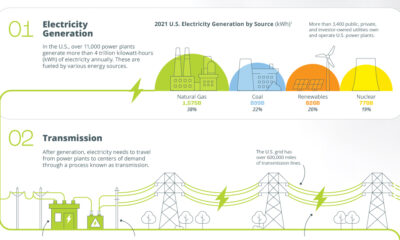
 Electrification1 year ago
Electrification1 year agoVisualized: How the Power Grid Works
-
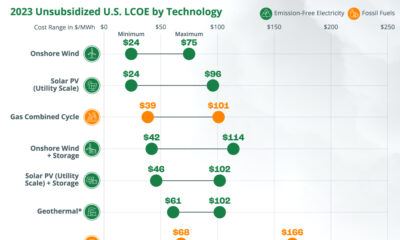
 Energy Shift9 months ago
Energy Shift9 months agoRanked: The Cheapest Sources of Electricity in the U.S.
-
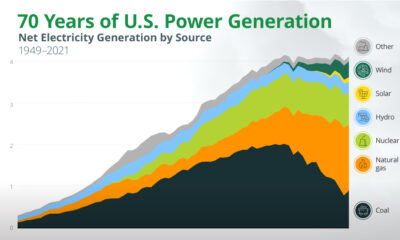
 Energy Shift1 year ago
Energy Shift1 year agoAnimated: 70 Years of U.S. Electricity Generation by Source
-

 Clean Energy1 year ago
Clean Energy1 year agoBreaking Down Clean Energy Funding in the Inflation Reduction Act
-
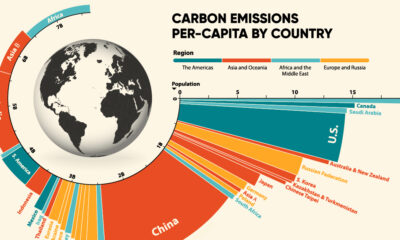
 Emissions1 year ago
Emissions1 year agoVisualizing Global Per Capita CO2 Emissions
-
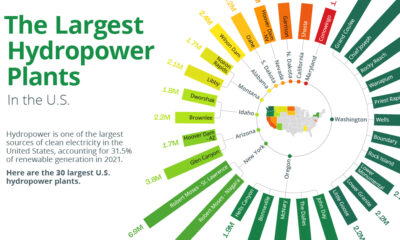
 Clean Energy1 year ago
Clean Energy1 year agoThe 30 Largest U.S. Hydropower Plants
-
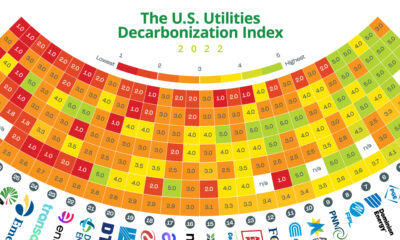
 Decarbonization1 year ago
Decarbonization1 year agoThe U.S. Utilities Decarbonization Index
-

 Clean Energy7 months ago
Clean Energy7 months agoBreaking Down the $110 Trillion Cost of the Clean Energy Transition

